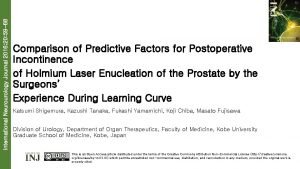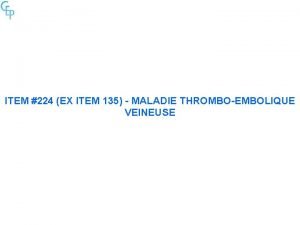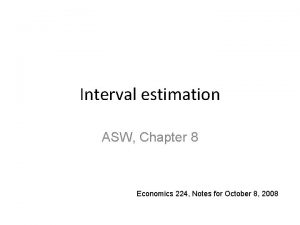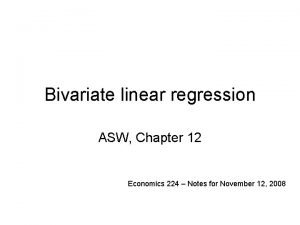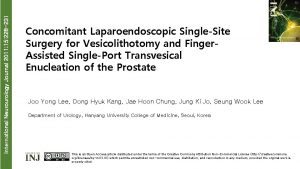International Neurourology Journal 2016 20 224 231 Stress













- Slides: 13

International Neurourology Journal 2016; 20: 224 -231 Stress Urinary Incontinence in Women With Multiple Sclerosis Caroline Massot 1, Hichem Khenioui 1, Olivier Agnani 1, Marc-Alexandre Guyot 1, Patrick Hautecoeur 2, Cécile Donze 1 1 Department of Physical and Rehabilitation Medicine, Saint Philibert Hospital, Lille, France 2 Department of Neurology, Saint Philibert Hospital, Lille, France This is an Open Access article distributed under the terms of the Creative Commons Attribution Non-Commercial License (http: //creativecommons. org/licenses/by-nc/3. 0/) which permits unrestricted non-commercial use, distribution, and reproduction in any medium, provided the original work is properly cited.

International Neurourology Journal 2016; 20: 224 -231 PURPOSE • To report the prevalence and risk factors of stress urinary incontinence (SUI) and the prevalence of intrinsic sphincter deficiency in women with multiple sclerosis (MS). METHODS • We conducted a retrospective study. • Female patients with MS, followed for lower urinary tract symptoms (LUTS) during a 15 -year period were included. • Demographic data, MS history, expanded disability status scale (EDSS) score at the urodynamic visit, obstetrical past, birth weight, LUTS, and urodynamic findings were collected. • SUI was defined as incontinence during cough,

International Neurourology Journal 2016; 20: 224 -231 RESULTS • We included 363 women with a mean age of 46. 7± 10. 8 years and a mean disease duration of 12. 9± 8. 7 years. The incidence of relapsing remitting MS, a secondary progressive form, and a primary progressive form was 60. 6%, 32. 8%, and 6. 6%, respectively. The prevalence of SUI was 31. 4%. The prevalence of intrinsic sphincter deficiency was 1. 4% and 0. 8% of these patients had a SUI (P=0. 300). In a multivariate analysis, women with a SUI had significantly higher birth weight (P=0. 030), a pelvic organ prolapse (P=0. 021), urgent urinary incontinence (P=0. 006), a lower EDSS score (P=0. 019), and a weaker containing effort (P<0. 001).

International Neurourology Journal 2016; 20: 224 -231 CONCLUSIONS • The prevalence of SUI in women with MS was 31. 4%. • This symptom could affect the quality of life of women with MS.

International Neurourology Journal 2016; 20: 224 -231 Table 1. Prevalence of SUI in MS by age range

International Neurourology Journal 2016; 20: 224 -231 Table 2. Clinical characteristics of MS patients

International Neurourology Journal 2016; 20: 224 -231 Table 3. Clinical characteristics of multiple sclerosis form of patients

International Neurourology Journal 2016; 20: 224 -231 Table 4. Low urinary tract symptoms in patients with multiple sclerosis

International Neurourology Journal 2016; 20: 224 -231 Table 5. Urodynamic investigations in patients with multiple sclerosis

International Neurourology Journal 2016; 20: 224 -231

International Neurourology Journal 2016; 20: 224 -231 Table 6. Results of logistic regression with backward model of risk factors of stress urinary incontinence in patients with multiple sclerosis

International Neurourology Journal 2016; 20: 224 -231

International Neurourology Journal 2016; 20: 224 -231 Fig. 1. Receiver operating characteristic curves of forward and backward models. AUC, area under the curve.
